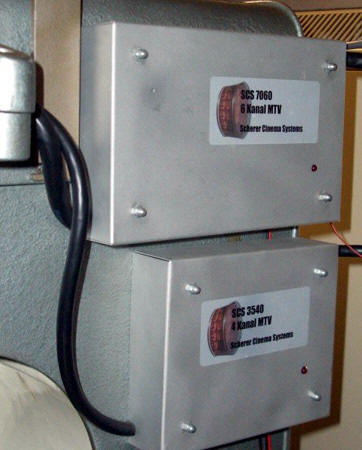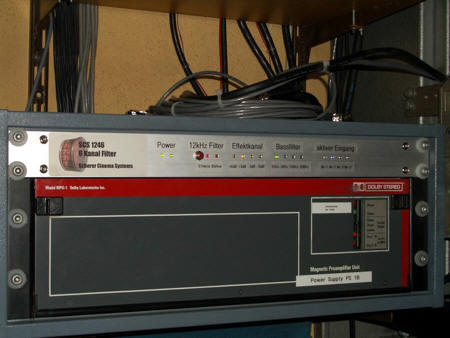Why new magnetic sound equipment for 35mm and 70mm prints? |
Read more
at in70mm.com The 70mm Newsletter |
| Written by: Clemens Scherer, Karlsruhe, Germany | Date: 16.01.2008 |
 Earlier solutions for the reproduction of magnetic sound recordings -
like the Dolby MPU - were developed having new prints in mind, being in
perfect condition. Also new calibration loops were available, often
especially made and delivered with a new print. Today this picture
changed completely. Only a few and already often used calibration loops
for 70mm are still in a good condition. These loops may not represent
exactly the frequency response and level of available prints, as there
was a spreading in calibration of the recording equipment. 35mm
calibration loops are not known to be available at all. Earlier solutions for the reproduction of magnetic sound recordings -
like the Dolby MPU - were developed having new prints in mind, being in
perfect condition. Also new calibration loops were available, often
especially made and delivered with a new print. Today this picture
changed completely. Only a few and already often used calibration loops
for 70mm are still in a good condition. These loops may not represent
exactly the frequency response and level of available prints, as there
was a spreading in calibration of the recording equipment. 35mm
calibration loops are not known to be available at all. |
More
in 70mm reading: More from Clemens Scherer Internet link: |
The current situation with magnetic sound playback |
|
|
1. Some prints got low frequency artefacts, that must not be reproduced, as
this frequency range was cut off by the original playback equipment. 2. Position and width of the four 35mm tracks were altered with the use of standard perforation holes. This effects especially the surround channel in level and signal to noise ratio. 3. The optional 12kHz signal on 35mm surround tracks was intended to open a gate, but never suppressed completely for playback in the auditorium due to weak filtering. Later this led to 35mm 4-track being often reduced to the three front channels with playback. 4. Meanwhile the available prints have been run on the projection equipment of many different theatres. Some theatres used equipment that was no more in a condition to handle the prints carefully or actually never meant to be used with magnetic prints. Unluckily these few theatres damaged the magnetic recordings of many prints in typical ways. Repeatedly they added a sharp clicking noise to the outside tracks, most likely by electrostatic charge with a fast periodic discharge on one side of the print. In very bad cases, falsely connected or damaged preamplifiers caused a recording current in the soundheads, adding a variety of distortions with different levels to certain tracks. Stupidly, missing or distorted channels were ignored and these theatres continued to leave there special mark on every print they would run. |
|
What can be done better now |
|
 SCS7060
and SCS3540, magnetic preamplifiers mounted at the DP70, Schauburg,
Karlsruhe SCS7060
and SCS3540, magnetic preamplifiers mounted at the DP70, Schauburg,
KarlsruheToday, if a print is mechanically still in a good condition and maybe dye
fading didn't yet destroy the colours completely, this print could still be
shown, if it is managed to avoid the audience being distracted and maybe
tormented by sound effects that were never meant to be there. |
|
The
Scherer Magnetton Vorverstärker (MTV)
|
|
 SCS
7060 (70mm 6-track MTV) at the DP70, Schauburg, Karlsruhe SCS
7060 (70mm 6-track MTV) at the DP70, Schauburg, KarlsruheFour new concepts: 1. The MTV is build up in standard analogue technology, but reduced to the minimum size necessary. This enables to install the board directly in the penthouse of the magnetic pick-up or as close as possible to it. So the most sensitive lines between the soundhead and the preamplifier can be kept as short as possible. This circumstance enables a solution without additional transformers in the line. In case of the MTV being housed in the penthouse there is maximum shielding for free by the usually massive body. 2. The MTV comprises inputs with a very high impedance. So the pure off-load voltage generated by the soundhead is amplified. A special input circuit disables any accidentally damaged input amplifier to generate a recording current in the soundhead and possibly compromise the cleanliness of the recording. This declares the MTV to be the perfect choice for playback of unique archive prints, helping to protect the magnetic recording the best way possible. 3. With the missing availability of pink noise recording calibration loops in 35mm 4-channel, to adjust the frequency response, the MTV offers trim-pots, that can be visually adjusted and represent a clearly defined range. This is very helpful with 35mm 4-channel setup, but also with 70mm 6-channel calibration with pink noise and level loops, as a strange trim-pot setup due to damaged calibration loop recording can be recognized and checked with another loop. 4. The idea of a gate for the surround track of 35mm magnetic sound recordings is improved. The original design of 20th Century Fox included a 12kHz pilot tone to open the gate. This solution arises the problem, that recordings without that pilot tone miss to open the gate, removing the surround sound in the auditorium - if the projectionist doesn't force the gate to be open permanently. But then the background noise reproduced by the surround speakers and filling the whole space around the audience, may be clearly audible with silent scenes and more distracting than noise from the stage channels. The new designed gate got a different solution, working for every type of recording. There is no switch to be in the wrong position. Removing of the optional 12kHz signal with 35mm CinemaScope type recordings is left to the filter unit, described subsequently. Beside the use for 35mm 4-track recording the gate is also available for the 6-channel Todd-AO type reproduction. The MTV is available for 70mm 6-track (SCS7060), 35mm 4-track (SCS3540) as well as for 16mm 2-track (SCS1620). |
|
The Scherer
Magnetton Filter (MTF)
|
|
 SCS
1246 (4 and 6-track MTF) and the Dolby MPU in the magnetic sound rack,
Schauburg, Karlsruhe SCS
1246 (4 and 6-track MTF) and the Dolby MPU in the magnetic sound rack,
Schauburg, KarlsruheSeven special features: 1. The unit includes input activation by automation control of up to four sources, adding an idle source if no external source is activated. This is necessary to avoid open lines and suppress idle noise. 2. With the 4-channel inputs a highly effective 12kHz-filter can be activated on the surround channel. For prints that suffer 12kHz crosstalk on the front tracks, 12kHz-filters can be activated on the stage channels, too. 3. With all inputs a second filter can be activated with certain levels of magnitude to adapt the frequency response of all channels to the variety of magnetic recording systems without touching the basic setup of the MTV. 4. With all inputs a third filter can be activated to adapt the low frequency response for a stronger pre-emphasis or to suppress low frequency noise, especially 50Hz distortion being recorded on the tracks accidentally. This filter being switchable enables to playback clean prints with the uncut low frequency bandwidth. 5. With all inputs a fourth filter can be activated to adapt the amplification of the surround channel for the different track width and level of 35mm 4-track recordings. 6. With all inputs gates can be activated separately on single channels, to suppress distortion within the whole reproduced frequency range up to a certain level. 7. All the filters and gates can be remote controlled, for the activation being done in the auditorium, to be able to find the best setting by directly listening for the speaker response of changes to the filter setting. The MTF is available for 35mm 4-track with 2 inputs (SCS1240) or full 35/70mm 4/6-track with 4 inputs (SCS1246) and with different feature sets, depending on intended tasks. |
|
|
Go: back
- top -
back issues
- news index Updated 22-01-25 |
|
